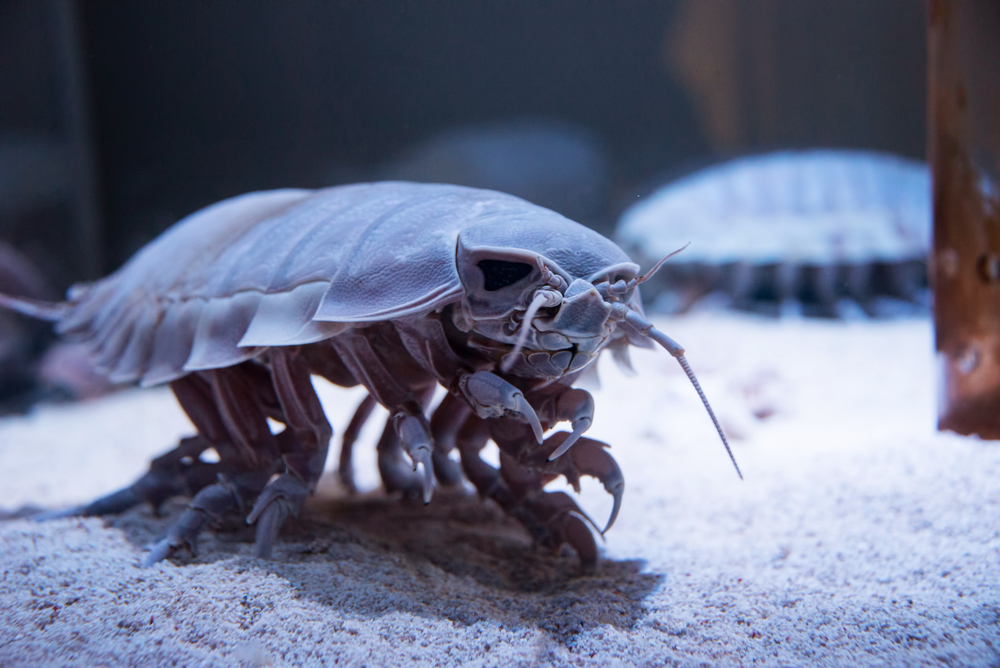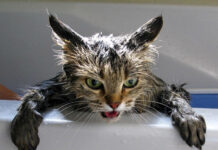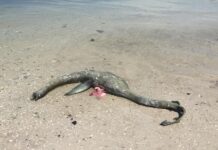You may have been to a zoo or two and think that you have seen all the animals that can be found on the planet. Wrong. There are many rare species that spend most of their lives under the radar. Some of them face extinction while others simply are hardly reachable. Here are 20 animals that you have probably never even heard of.
1 of 20

Goblin Shark
The goblin shark (Mitsukurina owstoni) is a rare species of deep-sea shark. This pink-skinned animal has a distinctive profile with an elongated, flattened snout, and highly protrusible jaws containing prominent nail-like teeth. It is usually between 3 and 4 m (10 and 13 ft) long when mature, though it can grow considerably larger. Goblin sharks inhabit upper continental slopes, submarine canyons, and seamounts throughout the world at depths greater than 100 m (330 ft), with adults found deeper than juveniles.
Panda Ant
The panda ant inhabits the Chilean sclerophyll forests at Coquimbo. The animal is colloquially known as panda ant due to its fur and coloration; with white coat covering all of its head except the eyes, and black and white spots appearing over the rest of its segments. Despite looking like an ant and being referred as such, it is in fact a form of wingless wasp.
Lowland Streaked Tenrec
An extraordinary-looking family, the tenrecs exist only in Madagascar and have a greater diversity of form than any other family of insectivores. Members of the subfamily Tenrecinae look like a cross between a shrew and a hedgehog, with long, pointed snouts and spines amongst their fur. Unusually for tenrecs, the lowland streaked tenrec is active both at night and during the day, and is the only species to form groups. It remains with its family, numbering up to 20 individuals in each burrow.
Hummingbird hawk-moth
The hummingbird hawk-moth is distributed throughout the northern Old World from Portugal to Japan, but it breeds mainly in warmer climates. Its long proboscis and its hovering behavior, accompanied by an audible humming noise, make it look remarkably like a hummingbird while feeding on flowers. he resemblance to hummingbirds is an example of convergent evolution.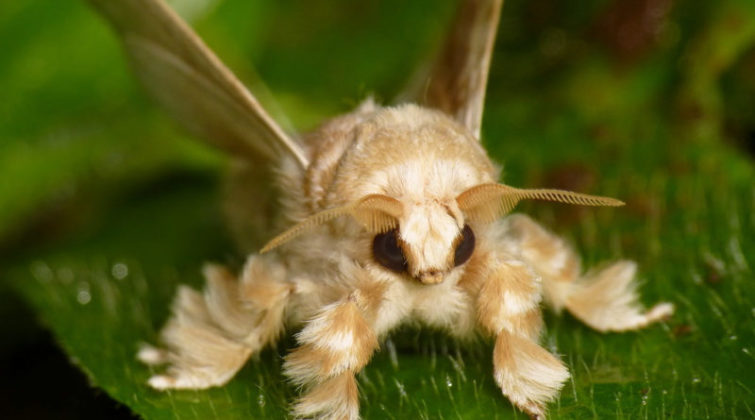
Venezuelan Poodle Moth
Venezuelan poodle moth was discovered in the year 2009 in the Gran Sabana region of Venezuela. The insect seems to be a blend of a large moth and a bright, fluffy white poodle.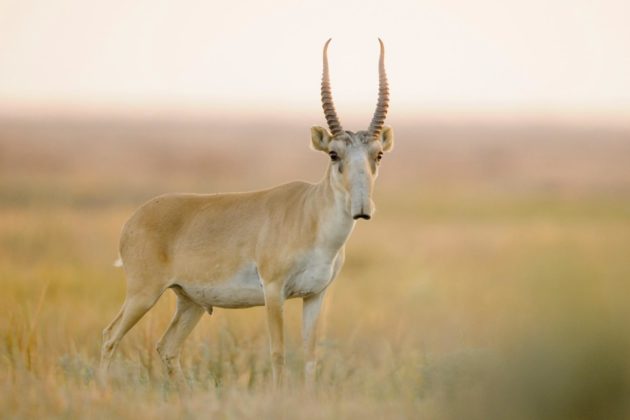
Saiga antelope
The saiga antelope is a critically endangered antelope that originally inhabited a vast area of the Eurasian steppe zone from the foothills of the Carpathian Mountains and Caucasus into Dzungaria and Mongolia. The large humped nose hangs over the mouth of the saiga. The nose is flexible and inflatable so helps it to breathe clean air during dusty summers and warm air during cold winters. Saiga antelope has long, thin legs but is similar in size to a sheep.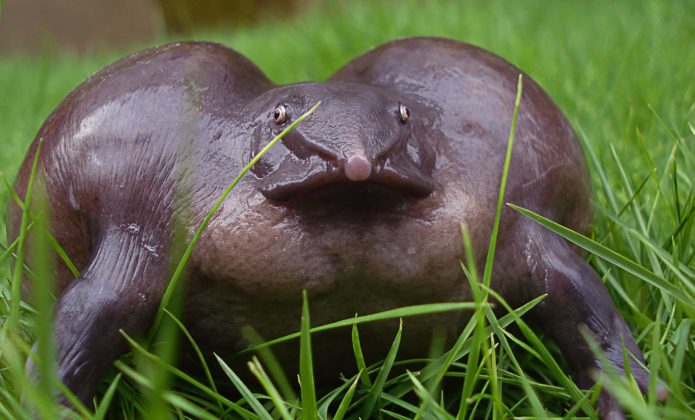
Indian purple frog
Nasikabatrachus sahyadrensis is a frog species belonging to the family Sooglossidae. It can be found in the Western Ghats in India. Names in English that have been used for this species are purple frog, Indian purple frog, or pignose frog. The body
appears robust and bloated and is relatively rounded compared to other frogs. It has a small head and an unusual pointed snout. Adults are typically dark purplish-grey in color.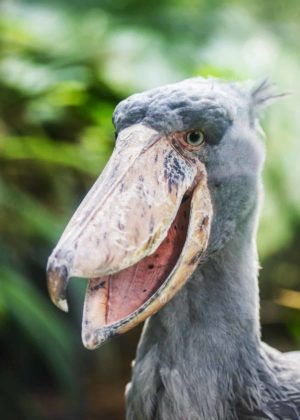
Shoebill
The shoebill (Balaeniceps rex) also known as whalehead, is a very large stork-like bird. It derives its name from its enormous shoe-shaped bill. It has a somewhat stork-like overall form and has previously been classified with the storks in the order Ciconiiformes based on this morphology. However, genetic evidence places it with the Pelecaniformes. It lives in tropical east Africa in large swamps from Sudan to Zambia. The shoebill is noted for its slow movements and tendency to stay still for long periods, resulting in descriptions of the species as "statue-like".
Narwhal
The narwhal is the unicorn of the sea, a pale-colored porpoise found in Arctic coastal waters and rivers. These legendary animals have two teeth. In males, the more prominent tooth grows into a swordlike, spiral tusk up to 8.8 feet (2.7 meters) long. The ivory tusk tooth grows right through the narwhal's upper lip. Scientists are not certain of the tusk's purpose, but some believe it is prominent in mating rituals, perhaps used to impress females or to battle rival suitors. 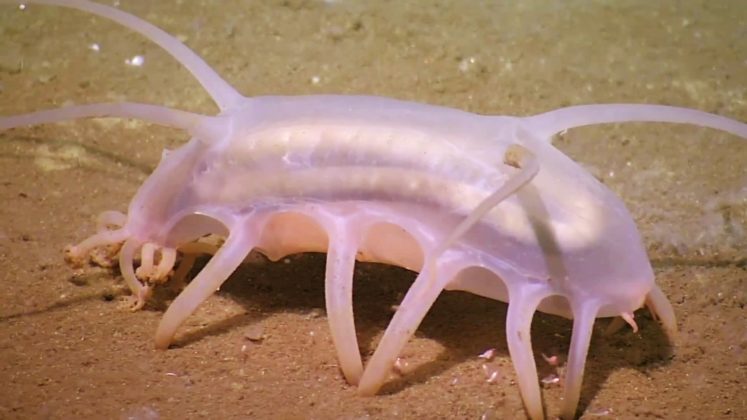
Sea Pig
Scotoplanes, commonly known as the sea pig, is a genus of deep-sea sea cucumbers of the family Elpidiidae. They have particularly enlarged tube feet that have taken on a leg-like appearance, using water cavities within the skin to inflate and deflate the appendages. Scotoplanes live on deep ocean bottoms, specifically on the abyssal plain in the Atlantic, Pacific and Indian Ocean, typically at depths of over 1200–5000 metres.
Thorny devil
The thorny devil (Moloch horridus) is an Australian lizard, also known as the mountain devil, the thorny lizard, or the moloch. The thorny dragon grows up to 20 cm (7.9 in) in length, and can live for 15 to 20 years. An intimidating array of spikes covers the entire upper side of the body of the thorny dragon. These thorny scales also help to defend it from predators. The thorny dragon's scales are ridged, enabling the animal to collect water from any part of its body by simply touching water, usually with their limbs; via the capillary principle water is transported to the mouth through their skin.
Okapi
The okapi (Okapia johnstoni), also known as the forest giraffe, congolese giraffe or zebra giraffe, is an artiodactyl mammal native to the northeast of the Democratic Republic of the Congo in Central Africa. Although the okapi bears striped markings reminiscent of zebras, it is most closely related to the giraffe. The okapi is medium-sized, standing 1.5 m (4.9 ft) tall at the shoulder. Its average body length is about 2.5 m (8.2 ft) and its weight ranges from 200 to 350 kg (440 to 770 lb). It has a long neck, and large and flexible ears. 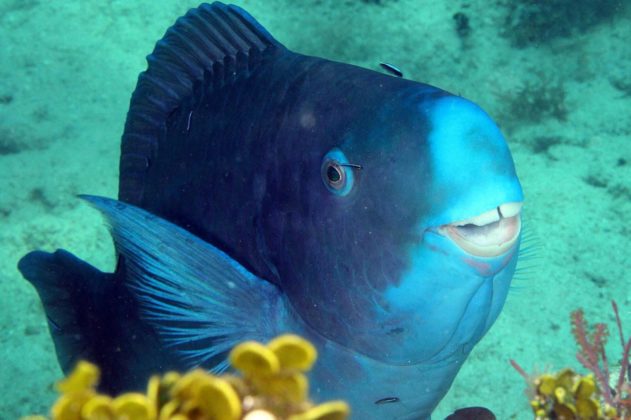
Blue Parrotfish
The blue parrotfish (Scarus coeruleus) is a member of the parrotfish genus Scarus. It is found on coral reefs in shallow water in the tropical and subtropical parts of the western Atlantic Ocean and the Caribbean Sea. They are uniformly blue with a yellow spot on their heads that fades as they age. They average 30–75 cm in length with a maximum length of 1.2 m. They develop a large "beak" like other parrotfish that is used for scraping algae and small organisms from rocks. They have pharyngeal teeth that grind ingested rocks into sand. No other species has this uniform blue color as adults.They weigh about 20 pounds (9 kg).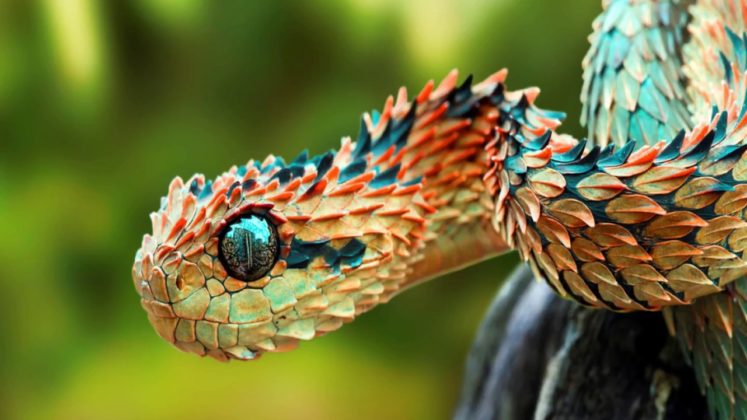
Bush Viper
Atheris is a genus of venomous vipers known as bush vipers. They are found only in tropical subsaharan Africa (excluding southern Africa) and many species have isolated and fragmented distributions due to their confinement to rain forests. They are relatively small in size, with adults ranging in total length (body + tail) from 40 cm (16 in) to a maximum of 78 cm (31 in). All species have a broad, triangular head that is distinct from the neck. Not much is known about their venom except that it is strongly hemotoxic, causing pain, swelling and blood clotting problems.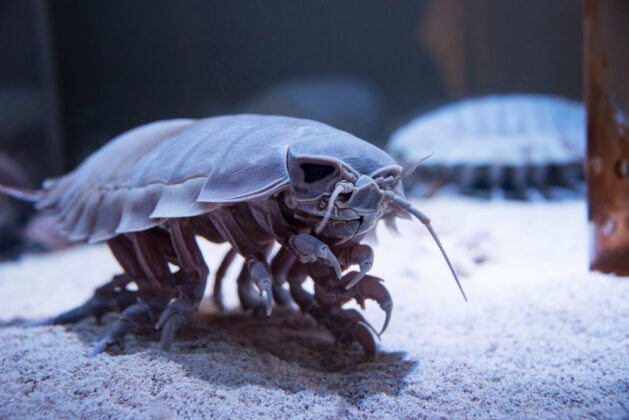
Giant Isopod
A giant isopod is any of the almost 20 species of large isopods (crustaceans distantly related to shrimp and crabs, which are decapods) in the genus Bathynomus. They are abundant in the cold, deep waters of the Atlantic, Pacific and Indian Oceans. The giant isopods are noted for their resemblance to the much smaller common woodlouse (pill bug), to which they are related. Giant isopods are of little interest to most commercial fisheries, but are infamous for attacking and destroying fish caught in trawls, and they are eaten in Taiwan. Giant isopods are a good example of deep-sea gigantism.
Pacu
Pacu is a common name used to refer to several species of omnivorous South American freshwater serrasalmid fish that are related to the piranha. Pacu and piranha do not have similar teeth, the main difference being jaw alignment; piranha have pointed, razor-sharp teeth in a pronounced underbite, whereas pacu have squarer, straighter teeth, which are uncannily similar to human teeth, and a less severe underbite, or a slight overbite. Pacu, unlike piranha, mainly feed on plant material and not flesh or scales. Additionally, the pacu can reach much larger sizes than piranha, at up to 1.08 m (3.5 ft) in total length and 40 kg (88 lb) in weight.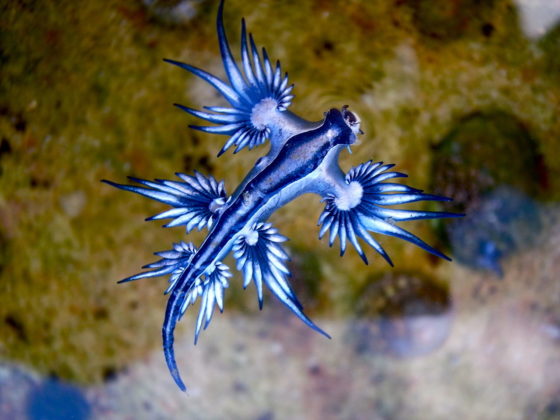
Blue Dragons
Glaucus atlanticus (common names include the sea swallow, blue angel, blue glaucus, blue dragon, blue sea slug and blue ocean slug) is a species of small, blue sea slug, a pelagic aeolid nudibranch, a shell-less gastropod mollusk in the family Glaucidae.
These sea slugs are pelagic: they float upside down by using the surface tension of the water to stay up, where they are carried along by the winds and ocean currents. They feed on on other pelagic creatures. This sea slug stores stinging nematocysts from the cnidarian within its own tissues as defense against predation. Humans handling the slug may receive a very painful and potentially dangerous sting.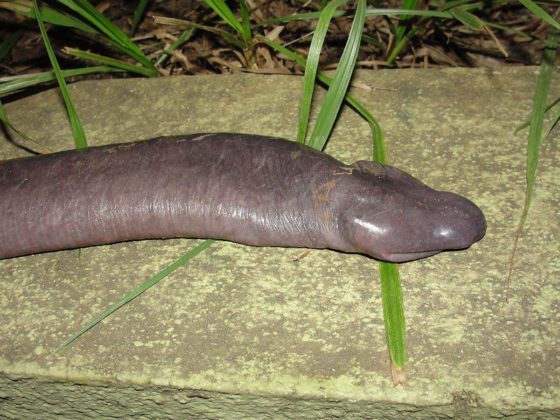
Penis Snake
Atretochoana eiselti (also known as "Penis Snake") is a creature discovered by engineers building a dam in the Amazon is a type of caecilian, a limbless amphibian that resembles an earthworm or as some are noting, part of the male anatomy. It is thought to be aquatic and lacks lungs, breathing through its skin instead. Atretochoana eiselti is the largest known caecilian, attaining a length of 81 cm (32 inches).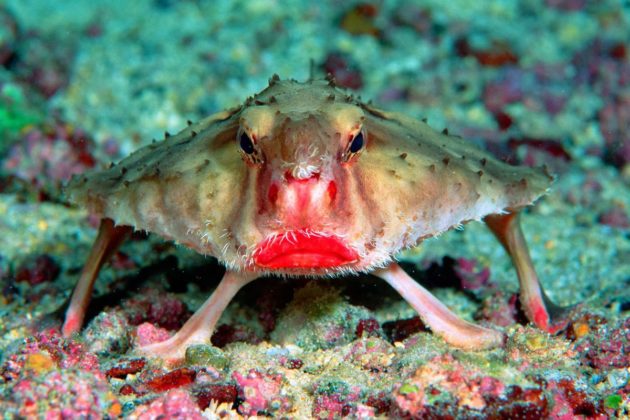
Red-lipped Batfish
The red-lipped batfish or Galapagos batfish (Ogcocephalus darwini) is a fish of unusual morphology found around the Galapagos Islands and off Peru at depths of 3 to 76 m (10 to 249 ft). This fish is mainly known for its bright red lips. Batfish are not good swimmers; they use their highly adapted pectoral fins to "walk" on the ocean floor. When the batfish reaches maturity, its dorsal fin becomes a single spine-like projection (thought to function primarily as a lure for prey). Like other anglerfish, the red-lipped batfish has a structure on its head known as illicium. This structure is employed for attracting prey.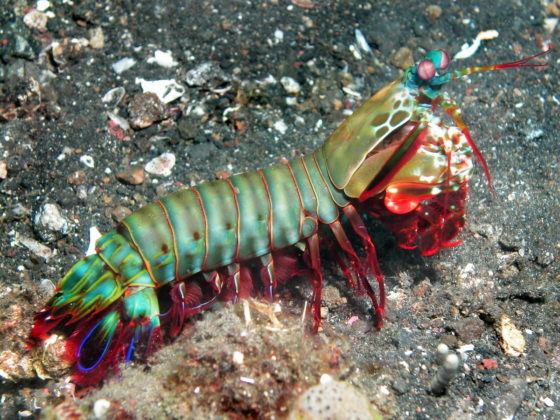
Mantis Shrimp
Mantis shrimps, or stomatopods, are marine crustaceans of the order Stomatopoda. Some species have specialised calcified "clubs" which can strike with great power, others have sharp forelimbs used to capture prey. They typically grow to around 10 centimetres (3.9 in) in length. A few can reach up to 38 cm (15 in). Called "sea locusts" by ancient Assyrians, "prawn killers" in Australia and now sometimes referred to as "thumb splitters" – because of the animal's ability to inflict painful gashes if handled incautiously – mantis shrimps have powerful claws that are used to attack and kill prey by spearing, stunning, or dismembering. In captivity, some larger species can break through aquarium glass.
